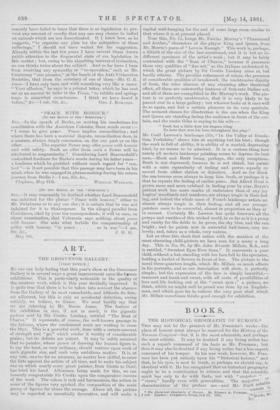ART.
THE GROSVENOR GALLERY.
[FIRST NOTICE.]
No one can help feeling that this year's show at the Grosvenor Gallery is in several ways a great improvement upon the farmer exhibitions. This is particularly noticeable in the quality of the amateur work, which is this year decidedly improved. It is quite true that there is to be taken into account the absence from the Gallery of its most remarkable, and hitherto its firm- est adherent, but this is only an accidental defection, owing entirely, we believe, to illness. We need hardly say that we are referring to Mr. Burne Jones. The feature of the exhibition in size, if not in merit, is the gigantic picture sent by Sir Coutts Lindsay, entitled "The Boat of Charon." It represents, of course, the well-known passage in the Inferno, where the condemned souls are waiting to cross the Styx. This is a powerful work, done with a certain amount of strength and "go," which render it worthy of considerable praise ; but its defects are patent. It may be safely assumed that no painter, whose power of drawing the human figure is, to say the least, so very ordinary, should venture upon work of such gigantic size, and such very ambitious motive. It is, at any rate, unwise for an amateur; no matter how skilful, to enter the lists against the artists of all time, and to make his subject one on which nearly every great painter, from Giotto to Dora, has tried his hand. Allowance being made for this, we can honestly congratulate Sir Coutts upon the comparative success of the work. The colour is rich and harmonious, the action in some of the figures very spirited, the composition of the main group of figures far above the average. Above all, the picture may be regarded as essentially decorative, and will make a capital wall-hanging for the end of some large room similar to that where it is at present placed.
Near this, No. 15, hangs Mr. Fairfax Murray's " Pharamond and Azalais," characters of the player King and Queen, from Mr. Morris's poem of " Love is Enough." This work is, perhaps, a fiftieth of the size of the last-mentioned, and it is but an in- different specimen of the artist's work ; but it may be fairly contrasted with the " Boat of Charon," because it possesses those very qualities of " fine art," as the Italians understood it, which the great picture by Sir Coutts Lindsay aims at, but hardly attains. The peculiar refinement of colour, the presence of considerable qualities of brushwork, the unobtrusive dignity of form, the utter absence of any straining after theatrical effect, all these are noteworthy features of first-rate Italian art, and all of them are exemplified in Mr. Murray's work. The pic- ture is so perfectly unobtrusive, that it is very likely to be passed over in a large gallery ; but whoever looks at it once will do so again, and feel a certain pleasure in its very quietude. The moment chosen for illustration is the one when the King and Queen are standing facing the audience in front of the cur-. taM, and the rustic Giles is saying to his wife :-
" Look but a little how his fingers cling To hors that was his love throughout the play."
Mr. Cecil Lawson's landscape (33), " Iu the Valley of Desola- tion, Yorkshire," shows him at anything but his best ; though the work is full of ability, it is ability of a morbid, depressing kind, by no means to be admired. It is a curious thing how nearly all modern landscape painting seems to depress its best men,—Hook and Brett being, perhaps, the only exceptions. Brett is not depressed, because he is not elated, but paints with a calm equanimity of feeling and power, equally re- moved from either elation or dejection. And as for Hook the sea-breezes seem always to keep him fresh, or perhaps it is that he repeats the feeling of earlier years. But Alfred Haut is grown more and more subdued in feeling year by year, Boyce's patient work has more marks of endurance than of any joy Legros' woodlands and meadows, are always tragic iu their feel ing, and indeed the whole mass of French landscape artists an almost always tragic in their feeling, and all our younger painters seem to be sorrowful, almost in proportion as they ar in earnest. Certainly Mr. Lawson has quite forsworn all the pomps and vanities of this wicked world, in so far as it is a pomp and vanity for the fields to be green, the sky blue, and the sun bright ; and he paints now in sorrowful half-tones, very un- lovely, and, taken as a whole, very untrue.
Let us close this short first notice with the mention of the most charming child-picture we have seen for a many a long day. This is No, 39, by Mr. John Everett Millais, R.A., and is entitled, " Sweetest Eyes Ever Seen." It represents a poor child, without a hat, standing with her face full to the spectator, holding a basket of flowers iu front of her. The picture is the usual three-quarters length, which Mr. Millais so much affects in his portraits, and as our description will show, is perfectly simple ; but the expression of the face is simply beautiful,— innocent and frank and sweet, with all sorts of possibilities of love and life looking out of the " sweet eyes ;" a picture, we think, which we might well be proud was done by an English- man, and which goes far to redeem the very poor stuff which Mr. Millais sometimes thinks good. enough for exhibition.






































 Previous page
Previous page